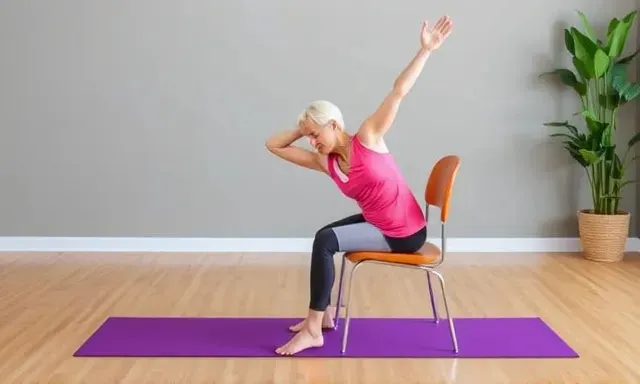How to Find Grace & Strength: A Guide to Yoga for Women Over 50
"By Omar Fadil"
Alleviating Menopause Symptoms Enhancing Bone Health Improving Flexibility and Balance with Chair Yoga
Part 1: Yoga for Menopause Symptoms – Reclaiming Balance and Ease
Hormonal Balancing: Certain yoga poses stimulate the endocrine system responsible for hormone production. By gently compressing and releasing glands like the thyroid, pituitary, and adrenal glands, yoga can help regulate hormone levels and alleviate symptoms like hot flashes and mood swings.Stress Reduction: Yoga is renowned for its calming effect on the nervous system. By combining deep breathing techniques with gentle movements and mindful meditation, yoga helps reduce cortisol (the stress hormone) and promotes relaxation, easing anxiety, improving sleep quality, and promoting emotional well-being.Improved Mood & Energy Levels: Yoga's positive impact on serotonin and dopamine levels – neurotransmitters associated with mood and happiness – makes it a powerful tool for combating mood swings and low energy levels often associated with menopause.Weight Management: Yoga, while not a high-impact workout, helps burn calories, build lean muscle mass, and boost metabolism. Combining regular yoga practice with a balanced diet can be an effective way to manage weight gain during menopause.
Supported Reclining Butterfly Pose (Supta Baddha Konasana): This restorative pose calms the nervous system, relieves anxiety, and promotes restful sleep.Legs-Up-the-Wall Pose (Viparita Karani): This gentle inversion improves circulation, reduces fatigue, and alleviates insomnia.Cobra Pose (Bhujangasana): A gentle backbend that stimulates the adrenal glands, helping to regulate cortisol levels and combat stress.Corpse Pose (Savasana): The ultimate relaxation pose, Savasana allows for deep relaxation, reduces tension, and promotes a sense of calm and well-being.
Part 2: Gentle Yoga for Bone Health – Strengthening from Within
Weight-Bearing Poses: Many yoga poses, despite being gentle, are considered weight-bearing. These poses, like Triangle Pose or Warrior II, require you to support your own body weight, putting stress on bones and encouraging new bone growth.Improved Balance & Coordination: Yoga enhances proprioception – your body's awareness of its position in space. This improved balance and coordination can help prevent falls, a major cause of fractures in older adults.Increased Flexibility & Range of Motion: Regular yoga practice improves flexibility and range of motion, which can be especially beneficial for maintaining joint health and mobility as we age.
Tree Pose (Vrksasana): Improves balance and strengthens the bones in the legs and feet.Triangle Pose (Trikonasana): Stretches the spine, strengthens the legs, and improves balance.Warrior II Pose (Virabhadrasana II): Builds strength in the legs, hips, and core while improving balance.Downward-Facing Dog (Adho Mukha Svanasana): Strengthens the arms, shoulders, and back while lengthening the spine.Mountain Pose (Tadasana): A foundational pose that improves posture, strengthens the core, and promotes body awareness.
Part 3: Chair Yoga for Seniors – Maintaining Mobility and Independence
Improved Mobility & Flexibility: Chair yoga uses gentle movements and stretches to improve the range of motion in the joints, making it easier to perform everyday activities.Increased Strength & Balance: Chair yoga incorporates modified versions of traditional yoga poses that strengthen the muscles surrounding the joints, improving stability and reducing the risk of falls.Reduced Joint Pain: Gentle movements and stretches in chair yoga can help lubricate joints, reducing stiffness and pain associated with conditions like arthritis.Improved Circulation & Energy Levels: Chair yoga promotes blood circulation and lymphatic drainage, boosting energy levels and reducing fatigue.
Seated Mountain Pose: Improves posture, strengthens the core, and promotes body awareness.Seated Cat-Cow Stretch: Increases spinal mobility and relieves back pain.Seated Warrior II: Strengthens the legs and core while improving balance.Seated Twist: Improves spinal flexibility and digestion.Seated Forward Bend (Paschimottanasana): Stretches the hamstrings and back, calming the nervous system.
Conclusion: Embracing the Journey of Aging Gracefully with Yoga
National Osteoporosis Foundation. (2021). Osteoporosis: Peak bone mass in women. Retrieved from https://www.nof.org/preventing-fractures/bone-basics/peak-bone-mass-in-women/ North American Menopause Society. (2021). Nonhormonal management of menopause symptoms. Retrieved from https://www.menopause.org/for-women/menopauseflashes/treatments/nonhormonal-management-of-menopause-symptoms Yoga Journal. (n.d.). Yoga for menopause. Retrieved from https://www.yogajournal.com/practice/yoga-for-menopause/



